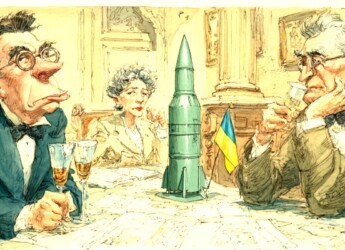Editor’s Note: Sourced from the Institute for the Study of War’s update dated September 19, 2025, this assessment highlights Estonia’s report that three Russian MiG-31s violated its airspace near Vaindloo Island for roughly twelve minutes—flying without filed plans and with transponders off—and Tallinn’s subsequent invocation of NATO Article 4, which triggered rapid allied air-policing under Operation Eastern Sentry with Italian F-35s and regional quick-reaction launches. It also notes Europe’s movement toward a defensive “drone wall,” localized Russian advances corroborated near Lyman, along the Kostyantynivka–Druzhkivka axis, and at Novoivanivka with indications around Muravka, Ukraine’s interdiction strike against a logistics hub in Kursk Oblast, and a large Shahed-type drone salvo against multiple regions. Closing this snapshot, readers should view these developments as interlinked signals about alliance readiness, cross-border escalation management, and the accelerating centrality of unmanned systems to the Russo-Ukrainian Conflict’s autumn campaign.
Content Assessment: Testing the Perimeter: Estonia Spurs NATO Scramble as Russia Probes and Ukraine Strikes
Information - 92%
Insight - 94%
Relevance - 92%
Objectivity - 93%
Authority - 95%
93%
Excellent
A short percentage-based assessment of the qualitative benefit expressed as a percentage of positive reception of the recent article from ComplexDiscovery OÜ titled, "Testing the Perimeter: Estonia Spurs NATO Scramble as Russia Probes and Ukraine Strikes."
Background Note: ComplexDiscovery’s staff offers distinctive perspectives on the Russo-Ukrainian war and Middle Eastern conflicts, informed by their military experience on the West German, East German, and Czechoslovakian borders during the Cold War, as well as in Sinai as part of Camp David Accord compliance activities, during the timeframe of the Persian Gulf War. This firsthand regional knowledge has been further enhanced by recent staff travels to Eastern European countries, including Estonia, Finland, Latvia, Lithuania, and Poland. These visits have provided up-to-date, on-the-ground insights into the current geopolitical climate in regions directly impacted by the ongoing conflict.
Combined with cybersecurity, information governance, and eDiscovery proficiency, this multifaceted experience enables comprehensive analysis of these conflicts, including the critical impact of cyber warfare, disinformation, and digital forensics on modern military engagements. This unique background positions ComplexDiscovery to provide valuable insights for conflict-related investigations and litigation, where understanding the interplay of technology, data, and geopolitical factors is crucial.
Russo-Ukrainian Conflict Update*
Testing the Perimeter: Estonia Spurs NATO Scramble as Russia Probes and Ukraine Strikes
ComplexDiscovery Staff
A twelve-minute slice of airspace over the Gulf of Finland became the sharpest edge of a wider struggle on September 19, as three Russian MiG-31 interceptors crossed into Estonia near Vaindloo Island, prompting NATO’s air policing to take action under Operation Eastern Sentry. The incident reverberated from Tallinn to Brussels, not because of the distance penetrated—less than ten kilometers—but because it illustrated a sustained Russian pattern of probing allied readiness while grinding forward in eastern and southern Ukraine. The day’s developments traced a continuous line from Article 4 consultations in NATO to local tactical advances near Lyman, the Kostyantynivka–Druzhkivka axis, and eastern Zaporizhia, with both sides leaning hard into unmanned systems that are reshaping mobility, evacuation, and logistics far behind the front.
Estonia characterized the incursion in stark terms: the Estonian General Staff reported that three transponder-silent MiG-31s, without published flight plans, flew parallel to Estonia’s border and then violated Estonian airspace near Vaindloo for approximately twelve minutes. NATO Supreme Headquarters Allied Powers Europe (SHAPE) stated that allied aircraft scrambled, including Italian F-35s based in Estonia, with Sweden and Finland also launching quick reaction alerts under Operation Eastern Sentry. Estonian officials noted this was the fourth such violation in 2025 and the most brazen to date; Tallinn invoked Article 4 to initiate allied consultations. NATO spokesperson Allison Hart described the Russian conduct as reckless, and NATO Secretary General Mark Rutte emphasized the speed and decisiveness of the allied response.
European policymakers, meanwhile, pushed toward a more durable answer to Russia’s expanding use of drones. EU Defense and Space Commissioner Andrius Kubilius said he would convene defense ministers to accelerate a defensive “drone wall” along the EU’s eastern frontier—a layered architecture of sensors, jamming, and interceptors—with cooperation from Ukraine, whose battlefield experience informs design choices. In parallel, a NATO representative told Ukrainian outlet Suspilne that allies delivered the first weapons purchased for Ukraine via the Prioritized Ukraine Requirements List (PURL), signaling a procurement bridge intended to move capabilities at scale.
Moscow’s rhetorical counterpoint hewed to familiar lines. Russian Foreign Ministry spokesperson Maria Zakharova claimed circumstances around the September 9–10 drone violation of Polish airspace remained unclear and criticized European defensive measures, continuing a pattern of denial even as European states harden defenses. Reporting also indicated that Russia is exploring sanctions-evasion mechanisms through energy-linked financial circuits: an internal memo from Vietnam’s Petrovietnam reportedly outlined how joint venture profits could be cycled to pay for Russian arms outside SWIFT, with balancing transfers through related state-owned entities—an approach consistent with the Kremlin’s broader effort to anchor war-economy flows in state energy firms.
Inside Ukraine, the contact line told a story of incremental Russian pressure paired with Ukrainian interdiction. Geolocated footage published on September 19 showed Russian soldiers planting a flag along the northern bank of the Siverskyi Donets in the Serebryanske forest area southeast of Lyman—an assessed advance consistent with Russia’s months-long attempt to manipulate the river line and unhinge Ukrainian defenses. Southward, visual evidence indicated a small Russian advance along a windbreak south of Oleksandro-Shultyne on the Kostyantynivka–Druzhkivka axis, a micro-gain that nonetheless narrows Ukrainian maneuver corridors toward Chasiv Yar and the Toretsk agglomeration. In eastern Zaporizhia Oblast, geolocated imagery showed a flag raised in southwestern Novoivanivka (northeast of Hulyaipole), indicating a recent Russian advance; ISW assesses that elements of the Russian 394th Motorized Rifle Regiment (127th Motorized Rifle Division, 5th Combined Arms Army, Eastern Military District) reportedly participated, a unit attribution retained with the “reportedly” qualifier pending independent confirmation. Around Novopavlivka, footage of a flag-raising in western Muravka suggested a likely Russian seizure; the Russian Ministry of Defense credited elements of the 35th Motorized Rifle Brigade (41st Combined Arms Army, Central Military District), though some Russian sources claimed Ukrainian positions persisted on Muravka’s northwestern edge.
The drone war is increasingly determined not just by attrition but by access. Ukrainian officials and unit spokespeople described the spread of fiber-optic “sleeper” FPV systems seeded along roads and tracks, activated to strike passing vehicles hours or days later. A senior Ukrainian officer in the Pokrovsk direction reported that Russian drones have expanded their practical range, making rear-area vehicle movement without electronic warfare coverage difficult in zones that were safer a month ago. In the Kostyantynivka sector, humanitarian volunteers said evacuation missions were canceled due to an uptick in drone threats. Zaporizhia Oblast Military Administration Head Ivan Fedorov stated that authorities are installing anti-drone netting over roads 15–20 kilometers from the line due to civilian casualties from fiber-optic FPV strikes—an illustration of how unmanned lethality is shaping civil-defense adaptations well behind the front.
Ukraine’s own long-range reach remained evident. Ukraine’s Special Operations Forces (SSO) reported that SSO drone operators struck the logistics hub of Russia’s 810th Naval Infantry Brigade in Kursk Oblast on the night of September 18–19, damaging an equipment storage site, an ammunition depot, and a concealed deployment point; geolocated footage showed explosions near Giri, Kursk Oblast. The Ukrainian State Border Guard Service separately reported drone strikes against a Russian fuel and lubricant warehouse, two drone launch locations, and communications/drone systems near Vovchansk.
Northern border belts stayed active. Russian forces attacked in Sumy and Kursk oblasts, including north and northeast of Sumy City, without confirmed territorial change; Russian milbloggers claimed intensified Ukrainian counterattacks near Oleksiivka, Yunakivka, Andriivka, and other settlements. A milblogger affiliated with the Russian Northern Grouping of Forces alleged that North Korean personnel are officially conducting security and demining tasks in Kursk Oblast and argued for broader employment—claims that reflect Moscow’s ongoing search for auxiliary capabilities. Rotations near Sadky and Oleksiivka reportedly incurred heavy losses, underscoring the churn imposed by contested border engagements and persistent drone observation.
In northern Kharkiv Oblast, Derhachi Hromada Military Administration spokesperson Oleksandr Kulik reported that Russian forces are remotely mining roads near Kozacha Lopan and employing fiber-optic FPV drones against passing cars and pedestrians, rendering organized evacuations impossible; Administration Head Vyacheslav Zadorenko added that booby-trapped firewood with remote detonators was discovered. Ukraine’s State Border Guard Service reported successful strikes near Vovchansk against Russian fuel and drone infrastructure, part of a broader interdiction effort to reduce Russian operational tempo.
The information environment inside Russia intersected with the military narrative. The Ministry of Justice designated Roman Alekhin—a milblogger and former advisor to the then-Kursk Oblast governor—a “foreign agent” for allegedly spreading false information about the military, following his September 9 arrest on embezzlement charges. Alekhin, who had criticized the state’s handling of Ukraine’s incursion into Kursk Oblast, rejected the designation, and some Russian milbloggers defended his frontline support work, revealing fissures within the pro-war information space even as the Kremlin tightens narrative control.
The human cost remained acute. The Ukrainian Kherson Oblast Prosecutor’s Office reported on September 19 that Russian soldiers executed three civilians in occupied Kozachi Laheri during the night of September 17–18. The Ukrainian Center for Journalistic Investigations, citing residents, stated that intoxicated Russian servicemen—possibly from the Russian 11th Airborne (VDV) Brigade—shot two civilians after being denied alcohol and then killed a third who arrived after hearing the gunfire. This assessment references the incident for its operational implications and unequivocally condemns violations of the laws of armed conflict.
Overnight between September 18 and 19, Russian forces conducted a large drone strike package. The Ukrainian Air Force reported that Russia launched 86 Shahed-type and decoy drones, including over 50 Shaheds, from directions including Kursk City, Shatalovo (Smolensk Oblast), Millerovo (Rostov Oblast), and Primorsko-Akhtarsk (Krasnodar Krai). Ukrainian air defenses reported downing or suppressing 71 drones, while 15 struck six locations and debris fell in two more; President Volodymyr Zelensky stated the strikes targeted Kyiv City and Kyiv, Donetsk, Sumy, Chernihiv, and Dnipropetrovsk oblasts, and Ukrainian officials reported damage to public transportation infrastructure in Kyiv and injuries in Pavlohrad, Dnipropetrovsk Oblast. The logic of these raids—saturate defenses, force expenditure, probe adaptive gaps—remains consistent as both sides brace for seasonal shifts that complicate maneuver and sustainment.
Taken together, September 19 underscored a strategic rhythm in which Russia combines measured provocation against NATO with attritional pushes along key Ukrainian axes, all while tightening domestic narrative control and exploring workarounds to sanctions. Ukraine and its partners answered with active air policing, PURL-enabled procurement, and border-to-rear adaptations to the drone threat. For ComplexDiscovery’s community—legal, cybersecurity, information governance, and intelligence professionals—the implications are immediate: sanctions-evasion pathways challenge diligence and transaction review; cross-border kinetic and unmanned activity reshapes data-sharing, export-control, and incident-response frameworks; and the evidentiary landscape grows more complex as information controls and battlefield churn create authenticatable but incomplete records. As autumn deepens and winter approaches, can allied adaptations—from a prospective EU “drone wall” to road-net hardening and supply-chain interdiction—outpace Russia’s probing cycle and blunt its incremental advances before today’s tactical edges harden into tomorrow’s operational realities?
Assessed Control of Terrain Map for September 19, 2025 (Vaindloo, Estonia)
Russian Air Incursion of Estonia - 091925About the Institute for the Study of War Research Methodology
ISW’s research methodology relies on both primary and secondary sources, enabling researchers to develop a comprehensive understanding of the situation on the ground. In order to analyze military and political developments in any given area, ISW’s research analysts must wholly understand the systems of enemy and friendly forces. They must also understand the population demographics, physical terrain, politics, and history of that area. This lays the analytical foundation for understanding the reasons for particular developments and fulfilling their assigned research objectives. ISW analysts also spend time in places like Iraq, Afghanistan, and elsewhere in order to gain a better understanding of the security and political situation and to evaluate the implementation of current strategies and policies. Their researchers compile data and analyze trends, producing a granular analysis of developments in areas of research, producing an accurate, high-resolution, timely, and thorough picture of the situation. ISW’s research methodology guarantees its success and commitment to improving the nation’s ability to execute military operations, achieve strategic objectives, and respond to emerging problems that may require the use of American military power.
About the Institute for the Study of War
The Institute for the Study of War advances an informed understanding of military affairs through reliable research, trusted analysis, and innovative education. They are committed to improving the nation’s ability to execute military operations and respond to emerging threats in order to achieve U.S. strategic objectives. ISW is a non-partisan, non-profit, public policy research organization.
Learn more, get involved, and contribute today.
Assisted by GAI and LLM Technologies
* Sourced and shared with permission from the Institute for the Study of War (ISW).
Additional Reading
- From Dissent to OSINT? Understanding, Influencing, and Protecting Roles, Reputation, and Revenue
- Data Embassies: Sovereignty, Security, and Continuity for Nation-States
Source: ComplexDiscovery OÜ



























